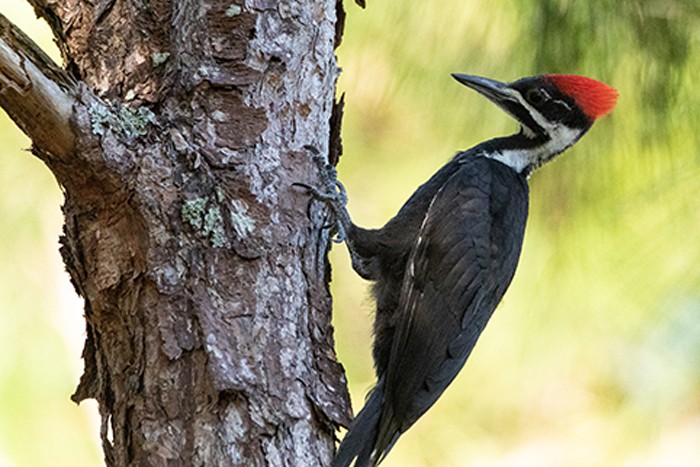Introducing the Tricks of Woodpeckers: Behavior, Habitat, and Much More
Woodpeckers, with their unique habits and specialized adjustments, have lengthy fascinated scientists and nature fanatics alike. By revealing the mysteries surrounding woodpeckers' habits and environment choices, a much deeper understanding of these bird wonders arises, providing a look right into their remarkable globe.
Woodpecker Behavior Insights
In checking out woodpecker behavior, an interesting screen of specialized abilities and adaptations arises, clarifying their remarkable environmental specific niche - Woodpeckers in Florida. Woodpeckers, known for their distinctive drumming on trees, possess a range of behavioral characteristics that add to their survival and success in their environment. One key habits is their drumming, which offers several objectives such as interaction, developing region, drawing in friends, and finding food sources. This rhythmic pecking also showcases their remarkable strength and endurance, as they can hammer away continuously at high rates without triggering damage to themselves.
In addition, woodpeckers show a distinct feeding actions defined by their capability to essence pests from tree bark utilizing their specialized beaks. Their long, barbed tongues help in capturing prey, while their strong neck muscular tissues provide stability and precision throughout pecking activities. This feeding strategy permits woodpeckers to gain access to concealed insect larvae and extract them with impressive performance.
Habitat Preferences and Selection
What elements affect the habitat choices and choice of woodpeckers? One important variable affecting woodpecker environment option is the availability of appropriate nesting websites. Woodpeckers typically favor forests with a mix of mature trees that provide enough opportunities for dental caries excavation.
Additionally, woodpeckers show a preference for environments with a plentiful supply of food sources. They are largely insectivorous, feeding on beetles, ants, larvae, and other bugs found in rotting wood or tree bark. Woodpeckers often tend to prefer wooded locations with a diverse insect population to satisfy their dietary demands.
In addition, the visibility of dead or rotting trees is one more crucial aspect in woodpecker habitat selection. These trees not only give food sources yet also supply ideal substratum for dental caries excavation. Dead trees are crucial for the maintenance of healthy and balanced woodpecker populaces, as they play a vital function in the woodpeckers' life cycle and community dynamics.
Feeding Behaviors and Diet Plan Make-up
Woodpeckers demonstrate a specialized feeding behavior concentrated on foraging for pests within numerous habitats. Their diet plan primarily includes bugs such as beetles, ants, caterpillars, and crawlers, which they find by tapping on tree bark and paying attention for the click here for more info sound of movement inside. Woodpeckers use their solid beaks to drill into the wood and their long, barbed tongues to remove target from gaps. Along with bugs, woodpeckers likewise eat tree sap, fruits, nuts, and seeds, adding range to their diet plan depending upon the period and accessibility of food sources.
The foraging methods of woodpeckers are well-adapted to their arboreal lifestyle (Woodpeckers in Florida). Their capability to excavate wood not only supplies them with food yet additionally aids in producing nesting dental caries and developing areas. Woodpeckers play a crucial role in keeping the health of woodlands by regulating insect populations and aiding in the decay of wood. Understanding their feeding habits and diet regimen make-up is vital for preservation initiatives aimed at protecting these distinct and important birds.
Drumming Sounds and Communication
Utilizing rapid drumming audios on numerous surface areas, woodpeckers use a distinctive kind of interaction to indicate territory borders and attract mates. This drumming habits is not only read review a means of communication yet likewise acts as a way for woodpeckers to establish their presence within a specific area. The strength, speed, and pattern of the drumming can communicate essential information to various other woodpeckers in the vicinity.
Woodpeckers utilize drumming audios to reveal their presence in a region and to caution off prospective trespassers. The loud and repeated nature of the drumming serves as a clear signal to other woodpeckers that the area is currently declared. This assists in reducing problems and minimizing physical fights in between individuals.

Survival Adaptations and Specialized Composition

Conclusion
To conclude, woodpeckers display distinct actions, such as drumming noises for communication, and have actually specialized anatomy for survival in their selected habitats. Their feeding habits and diet regimen make-up additionally show their adaptability to numerous settings. By recognizing these elements of woodpeckers, researchers and preservationists can better safeguard and preserve these remarkable birds and their ecosystems.